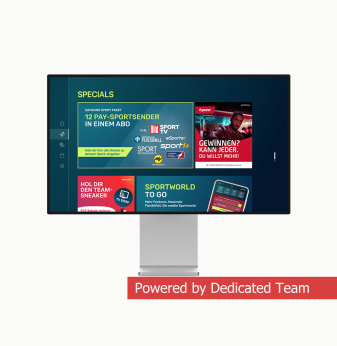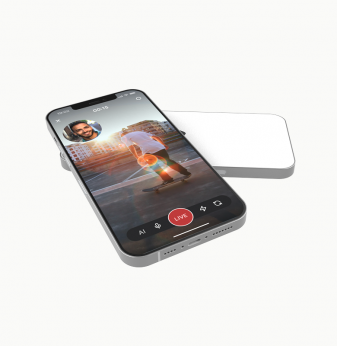Broadcast Better: The Ultimate Guide to ATSC 3.0 Technology
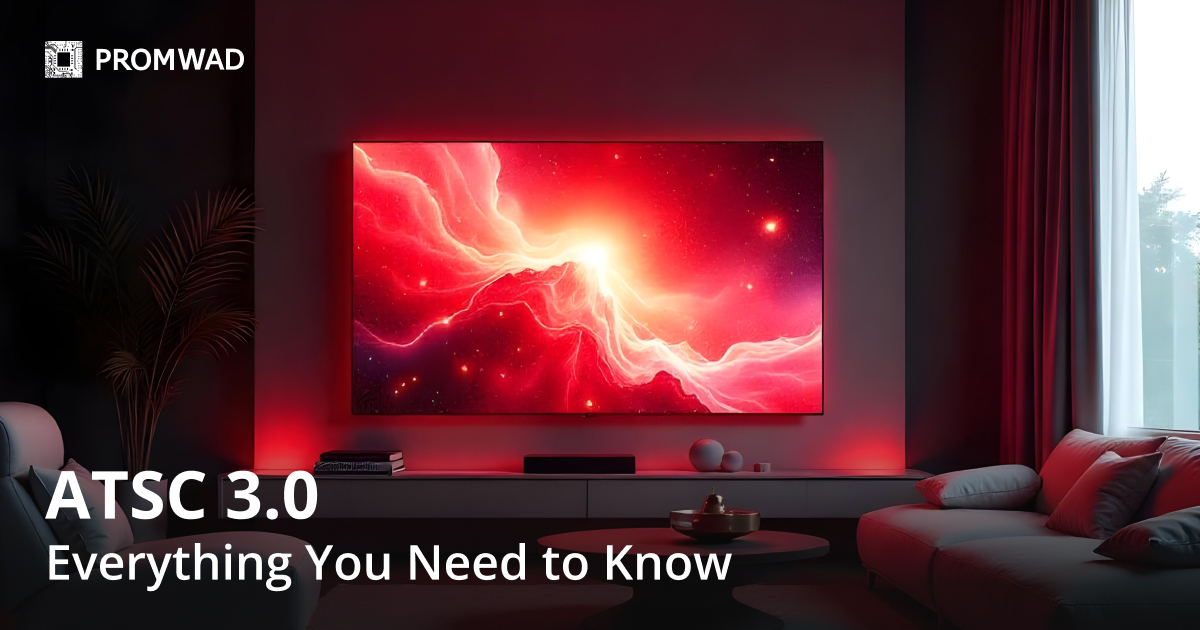

ATSC 3.0 transforms TV into a smarter, more versatile platform by combining traditional broadcasts' reliability with modern internet-based services' capabilities. It’s a win for consumers, broadcasters, and businesses, paving the way for a more connected, interactive and personalised future.
ATSC 3.0, also known as NextGen TV, offers a new step to enjoy high-quality content without needing internet charges. Radio waves transmit this signal over the air, providing free access to 4K broadcasts and interactive features. NextGen TV is compatible with many devices – beyond just smart TVs. With ATSC 3.0 tuners, users can enjoy this content on mobile devices, PCs, and other compatible screens.
The history of ATSC 3.0 begins with its origins in developing ATSC 1.0 during the 1990s. ATSC 1.0 revolutionised television by replacing analog broadcasts with digital ones, marking a significant technological leap. However, as TVs and viewing habits evolved – ushering in innovations like high-definition displays and internet streaming – the limitations of ATSC 1.0 became increasingly evident.
The development of ATSC 3.0 was initiated in the early 2010s to address these shortcomings and modernise TV broadcasting. By 2017, the FCC (Federal Communications Commission) approved ATSC 3.0 for voluntary adoption in the United States. Since then, the standard has gained global traction, with countries such as South Korea implementing it to support 4K UHD broadcasts, further highlighting its potential to transform the future of television.
Table of contents
Advantages of the implementation of ATSC 3.0
Where to use ATSC 3.0 standard
Real-life example: South Korea
The "bootstrap" mechanism in ATSC 3.0
Benefits of ATSC 3.0
ATSC 3.0 is the latest version of the standard TV broadcast. It’s designed to improve picture quality, sound, interactivity, and adaptability to modern technologies. Think of it as upgrading TV from an old flip phone to a modern smartphone: more features, better performance, and smarter capabilities.
Better picture and sound quality
Watching your favourite sports game in 4K with rich colours and stadium-like surround sound makes it feel like you’re there in person.
- 4K Ultra HD. ATSC 3.0 supports ultra-high-definition video (ATSC 3.0 4K TV), making shows and movies look sharper and more vibrant.
- HEVC (high efficiency video coding). ATSC 3.0 supports HEVC. It offers from 25% to 50% better data compression at the same level of video quality.
- HDR (high dynamic range). Colours are more realistic, and the contrast between light and dark scenes is much better.
- Immersive audio. With Dolby AC-4 sound, it feels like it’s coming from all around you, just like in a movie theater.
- MPEG-H 3D audio can support up to 64 loudspeaker channels.

You can watch a cooking show where you can click on-screen to get the recipe sent directly to your phone
Interactive TV
With ATSC 3.0 TV viewers can interact with broadcasts, such as voting during reality shows, accessing live stats during games, or exploring additional content.
Hybrid content delivery
After watching a TV show, you could immediately stream additional episodes or behind-the-scenes clips. Combining OTA (over-the-air) signals with broadband internet for on-demand features, enhanced program guides, and tailored advertising is possible.
Efficient broadcast
Users in a stormy rural area still receive clear emergency alerts and news updates on TV. ATSC 3.0 uses transmission based on packages, like the internet, to deliver content. This makes broadcasts more robust, even during bad weather.
Localisation
During a hurricane, you can receive a TV alert with evacuation routes for your neighbourhood.
Personalisation
You can also get targeted ads or news tailored to your location or interests and advanced emergency alerts, such as evacuation maps and multilingual updates.
Advantages of the implementation of ATSC 3.0
The ATSC 3.0 implementation offers many benefits, changing how content is delivered and how audiences interact.
First, it is a cost-effective delivery, allowing broadcasters to reach millions of viewers efficiently through a single broadcast signal.
ATSC 3.0 provides monetisation opportunities with targeted advertisements and premium interactive features, creating new revenue streams.
Additionally, the standard is designed with futureproofing in mind, it supports upcoming technologies such as ATSC 3.0 8K resolution and AI-driven services.
Benefits to viewers start with enjoy stunning of content 4K quality simply using an antenna. ATSC 3.0 also introduces interactive features that provide additional content and personalised experiences, enhancing audiences' engagement.
Furthermore, ATSC 3.0 supports advanced emergency services for alerts and vital information during critical situations to keep viewers informed and safe.
ATSC 3.0 supports transmission of multiple channels and language tracks in one signal.
ATSC 3.0 provides broadcasters many opportunities to maximise engagement and revenue through targeted advertising and hybrid solutions that combine traditional broadcasting with internet-based features.
ATSC 3.0 ensures reliable reception on multimedia devices, while efficient spectrum usage reduces transmission costs and expands capabilities on the same frequency band.
The system delivers a more stable signal even in challenging environments, minimises latency for live sports and breaking news, and supports real-time interactivity with features like on-demand content, live polls, and viewer participation.
ATSC 3.0 also allows for firmware updates to connected devices and offloads large-scale content distribution from the internet to over-the-air broadcasts.
Broadcasters can use ATSC 3.0’s precise geographic targeting for hyper-localised content, including regional ads, weather alerts, and news. Its advanced emergency alert systems provide rich media notifications, and hybrid models seamlessly blend over-the-air and OTT content delivery.
ATSC 3.0 supports data collection compliant with privacy regulations, offering insights into audience behavior to optimise programming and advertising.
With forward compatibility, ATSC 3.0 allows broadcasters to adopt emerging technologies like 8K resolution and immersive audio formats without huge infrastructure changes.
Where to use ATSC 3.0 standard
A wide range of ATSC 3.0 applications making it an adaptive solution for modern broadcasting and beyond:
- Enhanced TV entertainment. Ultra HD live sports, immersive movie experiences, and interactive reality shows.
- Emergency alert systems. Deliver critical information (e.g., evacuation maps) during natural disasters or emergencies.
- Education. Schools can broadcast lessons or educational content directly to students’ TVs.
- Public health. Governments can use ATSC 3.0 to send health alerts and updates to specific regions.
- Automotive applications. Vehicles equipped with ATSC 3.0 receivers can get real-time traffic updates, emergency alerts, and in-car entertainment and over-the-air firmware updates to ensure systems remain current and optimised.
- Internet of Things. ATSC 3.0 supports integration with IoT devices, enabling new services and expanding the smart home ecosystem.
Real-life example: South Korea

Presence and involvement of major broadcasters such as MBC, SBS, and KBS in ATSC 3.0 deployments across the country. Source: atsc.org
South Korea fully embraced ATSC 3.0 standard in 2017 for its national broadcasting system. They use it to:
- Broadcast 4K UHD content of the Olympics and major events.
- Provide interactive services like real-time sports stats.
- Enhance emergency alerting during natural disasters, ensuring clear, localised instructions.
The 'bootstrap' mechanism in ATSC 3.0
The "bootstrap" mechanism is a specific process to initialise and start communication between the broadcasting system and a receiver (e.g., a TV or set-top box). It sets the foundation for receiving and processing digital television signals.
Here’s how the bootstrap mechanism applies in ATSC 3.0:
- Signal discovery. When a receiver is turned on, it doesn’t know what kind of content or signal parameters it’s about to handle (e.g., audio, video, data). The bootstrap acts like a "beacon," allowing the receiver to detect the presence of an ATSC 3.0 signal.
- Low-level initialisation. The bootstrap is a small, robust signal designed to be reliably detected even under challenging conditions (like poor signal quality). It provides information about the signal format and how to process it further.
- Mode and configuration information. The bootstrap contains metadata that tells the receiver how to decode subsequent transmission parts. For example, it details modulation type (how the signal is encoded), bandwidth and frequency settings, whether the content is for live TV, on-demand streaming, or other services.
- Compatibility with future standards. The bootstrap is designed to be future-proof, supporting additional features or formats that may be introduced in later updates of ATSC standards.
In simple terms, the bootstrap in ATSC 3.0 helps a receiver figure out how to start interpreting a digital broadcast signal, ensuring compatibility and reliability for modern TV services. Without it, the receiver wouldn’t know how to begin decoding the data stream.
How mobile devices receive ATSC 3.0 signals
By leveraging OTA broadcast technology, mobile devices can receive ATSC 3.0 signals without using cellular data. ATSC 3.0 combines traditional broadcast methods with modern digital capabilities and allows mobile devices to act as receivers for television signals.
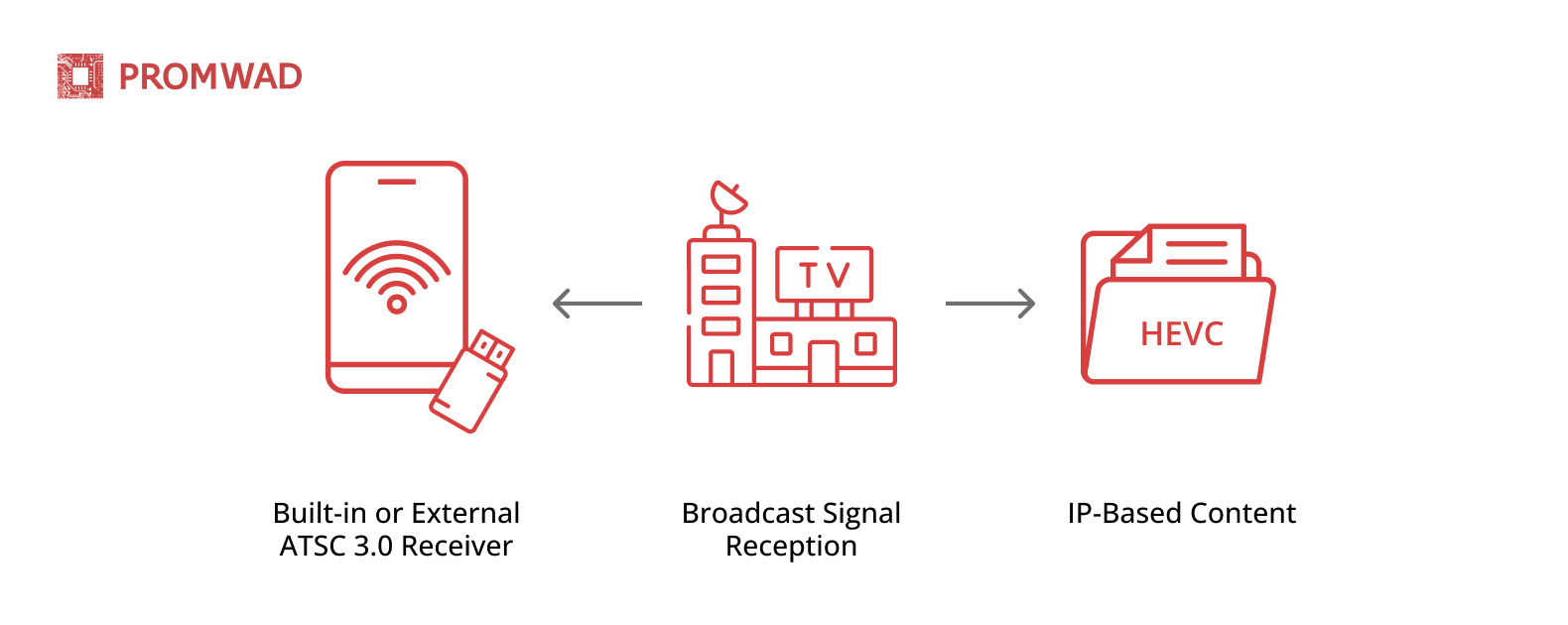
The workflow and components involved in the ATSC 3.0 standard
Mobile devices use dedicated ATSC 3.0 tuners and OTA broadcast technology to receive content without requiring cellular data, combining the benefits of traditional broadcasting with modern IP-based features.
Here are the main benefits of ATSC 3.0 in this application:
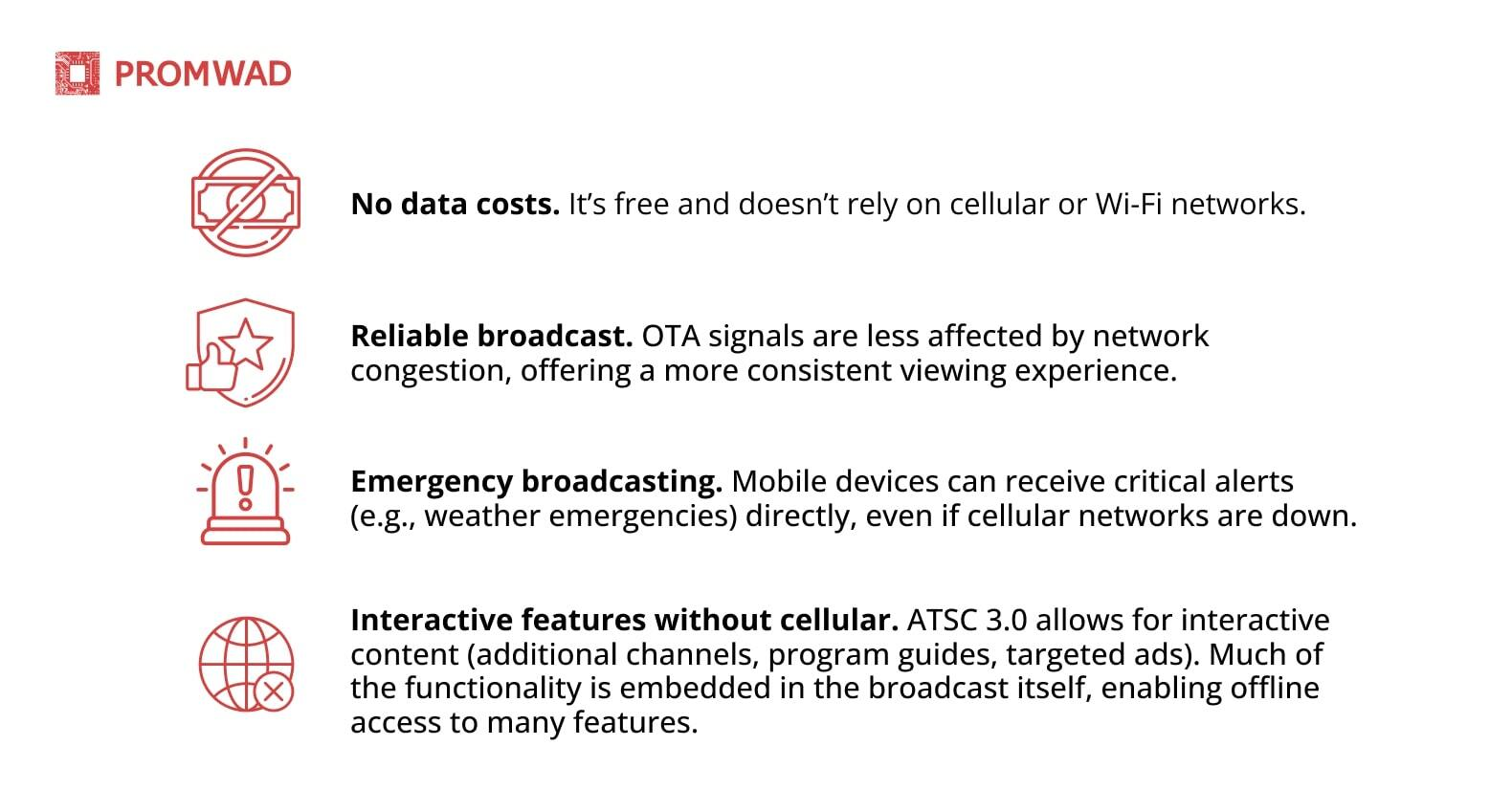
ATSC 3.0 deployment
Implementing ATSC 3.0 requires a collaborative approach by TV operators and device manufacturers to develop and integrate new hardware and software solutions that support the advanced features of the standard. Here's a breakdown of what each can do:
TV Operators
TV operators play a vital role in adapting their broadcasting infrastructure and providing enhanced services. What can they do?
1. Upgrade transmission infrastructure
- Replace or upgrade existing transmitters to support ATSC 3.0 modulation schemes (e.g., OFDM).
- Implement advanced encoders for HEVC video compression.
- Use IP-based multiplexers for delivering multimedia streams.
- Ensure compatibility with interactive and targeted advertising tools.
- Enhance systems for monitoring signal quality and ensuring delivery.
2. Enable hybrid services
- Deploy solutions to combine OTA broadcasts with broadband services, enabling features like on-demand content, interactive program guides, and personalised ads.
- Adopt middleware to manage and integrate broadcast and online delivery seamlessly.
3. Deploy emergency alert systems
- Implement AEI (advanced emergency information) capabilities in compliance with ATSC 3.0.
- Ensure readiness for localised alerts with detailed instructions, maps, and multimedia.
4. Collaborate with content providers
- Work with content creators to produce content optimised for 4K HDR, immersive audio (Dolby AC-4), and interactive features.
Device manufacturers
Device manufacturers need to design hardware and software solutions for TVs, set-top boxes, and mobile devices:
1. Develop ATSC 3.0 tuners
- Design next-generation set-top boxes and TVs with ATSC 3.0 tuners and demodulators, USB or plug-in devices for laptops and mobile phones.
- Ensure tuners are low-power and compact for mobile applications.
2. Upgrade decoding hardware
- Integrate hardware support for HEVC video decoding for 4K UHD content, advanced audio formats like Dolby AC-4, and IP-based packet processing for multimedia data streams.
- Include smart antenna technology to improve signal reception in mobile and indoor scenarios.
3. Design user interfaces (UI/UX)
- Create intuitive software interfaces for navigating hybrid broadcast and broadband content and managing interactive features, such as on-demand access or live polling.
- Add support for accessibility features like captions, language switching, and audio descriptions.
4. Interactivity
- Implement middleware to handle ATSC 3.0’s interactive features, such as HbbTV-like capabilities (e.g., integrating apps with broadcast content) and second-screen synchronisation with smartphones and tablets.
- Use HTML5 or similar technologies to enable interactive applications.
5. Mobile devices support
- Integrate ATSC 3.0 support in smartphones and tablets: miniaturised tuners or SDR solutions and antenna designs that work for portable devices.
- Develop apps that manage broadcast content and interactive features.
Collaboration between TV operators and device manufacturers is essential to ensure compatibility and fully realise the potential of ATSC 3.0. This joint effort begins with strict adherence to the Advanced Television Systems Committee standards for better integration of hardware and software.
Cross-industry testing is important in achieving signal compatibility, software interoperability, and robust security. It is the way to create a unified ecosystem for next-generation broadcasting.
Secure content delivery is another critical focus area, with DRM (digital rights management) mechanisms safeguarding premium content. Hardware-level encryption and decryption support further enhanced protection and provide a secure framework for delivering high-quality programming to consumers.
Equally important is consumer education, which involves promoting the benefits of ATSC 3.0, such as free 4K content, interactive features, and advanced emergency alert systems. Educational resources and setup guides for ATSC 3.0-enabled devices empower users to embrace the technology with confidence.
Want to integrate ATSC 3.0 into your product?
Our Case Studies in Video Streaming Solutions

